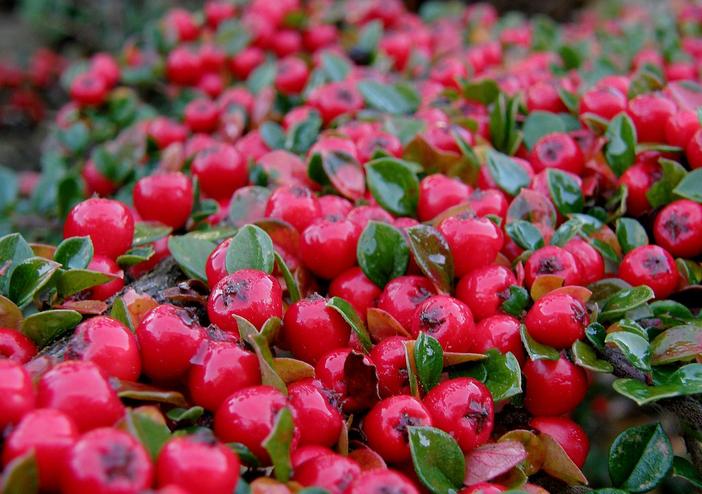Rockspray Cotoneaster
(Cotoneaster horizontalis var. perpusillus)
Rockspray Cotoneaster (Cotoneaster horizontalis var. perpusillus)
/
/

OliBac
CC BY 2.0
Image By:
OliBac
Recorded By:
Copyright:
CC BY 2.0
Copyright Notice:
Photo by: OliBac | License Type: CC BY 2.0 | License URL: https://creativecommons.org/licenses/by/2.0/ | Uploader: OliBac | Publisher: Flickr



Estimated Native Range
Summary
Cotoneaster horizontalis var. perpusillus, commonly known as Rockspray Cotoneaster, is a deciduous shrub native to the rocky hillsides and forest margins of Western and Central China. It exhibits a moderate growth rate, reaching heights of 1-3 feet (0.3-0.9 meters) and spreading 6-8 feet (1.8-2.4 meters) wide. The plant is characterized by its distinctive herringbone pattern of branches and small, glossy green leaves. In late spring to early summer, it produces a profusion of small, pink flowers that are followed by bright red berries in the fall, which persist into winter and provide visual interest as well as food for birds.
Rockspray Cotoneaster is valued for its low maintenance, its ability to stabilize slopes and banks, and its use as a ground cover or in rock gardens. It is also suitable for bonsai. This plant thrives in full sun to part shade and adapts to a variety of soil types, including clay, loam, or sandy soils, provided they have medium to fast drainage. It requires moderate watering but can tolerate some drought once established. While it is generally disease-resistant, it can be susceptible to fire blight and scale insects. Due to its spreading habit, it can be invasive in some regions, so it is essential to consult local guidelines before planting it outside its native range.CC BY-SA 4.0
Rockspray Cotoneaster is valued for its low maintenance, its ability to stabilize slopes and banks, and its use as a ground cover or in rock gardens. It is also suitable for bonsai. This plant thrives in full sun to part shade and adapts to a variety of soil types, including clay, loam, or sandy soils, provided they have medium to fast drainage. It requires moderate watering but can tolerate some drought once established. While it is generally disease-resistant, it can be susceptible to fire blight and scale insects. Due to its spreading habit, it can be invasive in some regions, so it is essential to consult local guidelines before planting it outside its native range.CC BY-SA 4.0
Plant Description
- Plant Type: Shrub
- Height: 1-3 feet
- Width: 6-8 feet
- Growth Rate: Moderate
- Flower Color: N/A
- Flowering Season: Spring
- Leaf Retention: Deciduous
Growth Requirements
- Sun: Full Sun, Part Shade
- Water: Medium
- Drainage: Fast, Medium
Common Uses
Border Plant, Groundcover, Hedges, Low Maintenance, Rock Garden, Street Planting
Natural Habitat
native to the rocky hillsides and forest margins of Western and Central China
Other Names
Common Names: Wall Cotoneaster , Xiao Ye Ping Zhi Xun Zi
Scientific Names: Cotoneaster horizontalis var. perpusillus , Cotoneaster distichus subsp. perpusillus , Cotoneaster distichus var. perpusillus , Cotoneaster horizontalis var. saxatilis , Cotoneaster perpusillus , Cotoneaster perpusillus , Pyrus perpusilla
GBIF Accepted Name: